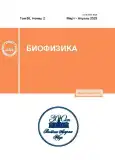Stability of collagen gel after uv irradiation
- Autores: Nashchekina Y.A1,2, Trusova N.A1, Nikonov P.O1, Nashchekin A.V2, Mikhailova N.A1
-
Afiliações:
- Institute of Cytology, Russian Academy of Sciences
- Ioffe Institute, Russian Academy of Sciences
- Edição: Volume 68, Nº 2 (2023)
- Páginas: 257-262
- Seção: Articles
- URL: https://journals.rcsi.science/0006-3029/article/view/144424
- DOI: https://doi.org/10.31857/S0006302923020060
- EDN: https://elibrary.ru/CALMAF
- ID: 144424
Citar
Texto integral
Resumo
Palavras-chave
Sobre autores
Yu. Nashchekina
Institute of Cytology, Russian Academy of Sciences;Ioffe Institute, Russian Academy of Sciences
Email: nashchekina.yu@mail.ru
St. Petersburg, Russia
N. Trusova
Institute of Cytology, Russian Academy of SciencesSt. Petersburg, Russia
P. Nikonov
Institute of Cytology, Russian Academy of SciencesSt. Petersburg, Russia
A. Nashchekin
Ioffe Institute, Russian Academy of Sciences
N. Mikhailova
Institute of Cytology, Russian Academy of SciencesSt. Petersburg, Russia
Bibliografia
- A. Bailey and R. Paul, J. Soc. Leather Technol. Chem., 82, 104 (1998).
- S. Ricard, Perspect. Biol., 1, 3 (2011).
- S. Ricard-Blum, Perspect. Biol., 3, 1 (2011).
- Yu. А. Nashchekina, А. А. Starostina, N. А. Trusova, et al., J. Physics: Conf. Series, 1697, 012053 (2020).
- A. Amaro-Ortiz, B. Yan, and J. A. D'Orazio, Molecules, 19, 6202 (2014).
- Yu. A. Nashchekina, N. M. Yudintceva, P. O. Nikonov, et al., Bull. Exp. Biol. Med., 163, 123 (2017).
- M. G. Haugh, C. M. Murphy, R. C. McKiernan, et al., Tissue. Eng. Part A, 17, 1201 (2011).
- Y. Hu, L. Liu, W. Dan, et al., Int. J. Biol. Macromol., 55, 221 (2013).
- S. J. Hollister and R. D. T. Maddox, J. Biomater., 23, 4095 (2002).
- J. S. Pieper, T. Hafmans, J. H. Veerkamp, et al. Biomaterials, 21, 581 (2000).
- M. G. Haugh., PhD Thesis (Trinity Colledge, Dublin University, Ireland, 2008).
- D.-H. Lew, P. H-T. Liu, and D. P. Orgill, J. Biomed. Mater. Res. B. Appl. Biomater., 82, 51 (2007).
- L. H. Olde Damink, P. J. Dijkstra, M. J. van Luyn, et al., Biomaterials, 17, 765 (1996).
- N. Davidenko, D. V. Bax, C. F. Schuster, et al., Mater. Sci.: Mater. Med., 27,14 (2016).
- N. Metreveli, L. Namicheishvili, K. Jariashvili, et al., Int. J. Photoenergy, 76830, 1 (2006).
- M. P. Ohan, K. S. Weadock, and M. G. Dunn, J. Biomed. Mater. Res., 60, 384 (2002).
- G. Chandrakasan, D. A. Torchia, K. A. Piez, J. Biol. Chem., 251, 6062 (1976).
- O. H. Lowry, N. J. Rosbrough, A. L. Farr, and R. J. Randall, J. Biol. Chem., 193, 265. (1951).
- Y. Nashchekina, A. Chabina, A. Nashchekin, et al., Polymers, 12, 1042 (2020).
- A. Sionkowska, J. Photoch. Photobiol. B: Biology, 82, 9 (2006).
- A. Kaminska and A. Sionkowska, Pol. Degr. Stability, 51,19 (1996).
Arquivos suplementares









